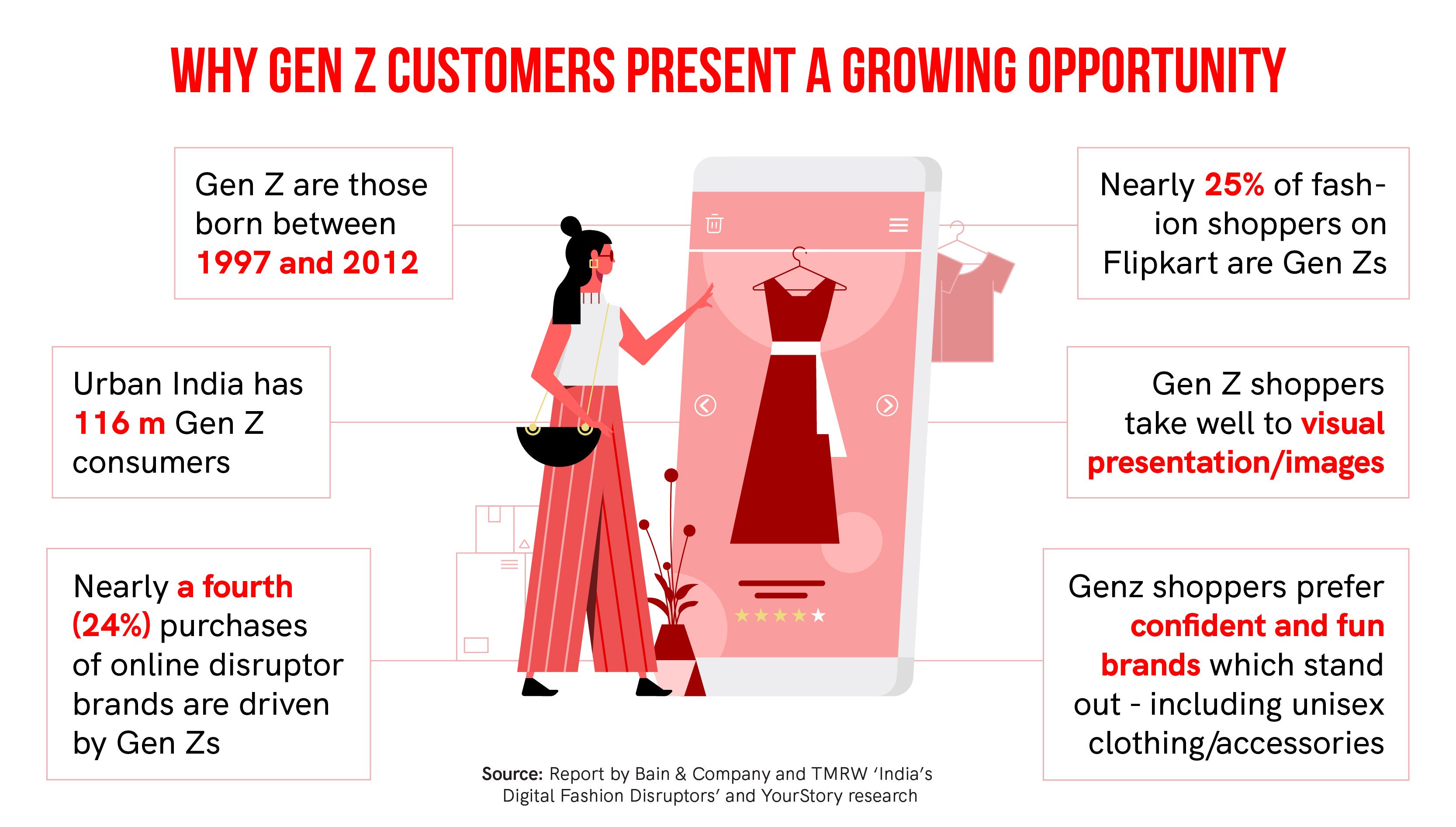
Gen Z shoppers in India, aged below 26 years, are the new target group for fashion brands–both online and offline. Right from legacy fashion retailers to online marketplaces, niche offerings for Gen Z shoppers have been on the rise, with clear messaging, affordable price points, and keeping up with international trends.
Over the last two months, players like Reliance Retail and have launched ‘youth-centric’ brands to cater to Gen Zs. While launched its first YOUSTA store in Hyderabad in August apart from retailing on its ecommerce app AJIO, ecommerce major Flipkart announced the launch of its app-in-app platform . In May this year, Flipkart group company announced the launch of a similar feature on its app–FWD, while Tata Trent has plans to expand its affordable fashion brand, Zudio, to 130 stores in 2023.
These ventures are catering to the growing Gen Z shoppers who make up for nearly a third of the online shopper base in India, according to a recent report by Bain & Company and ABFRL backed house of brands, TMRW.
“With approximately 116 million Gen Z consumers in urban India, this is a crucial segment for retailers to target and retain. The segment is responsible for driving the fastest growth for categories such as fashion, sneakers, smartwatches, and wearables–witnessing an increase of 105% year-on-year in the first half of 2023 (From January to July),” Naveen Malpani, Partner at consultancy firm Grant Thornton Bharat, tells YourStory.
“Nearly 25% of Flipkart users are Gen Z,” says Sandeep Karwa, Vice President at Flipkart Fashion. He adds that this crop of users do not like clicking on buttons and prefer visuals to detailed catalogue. Fashion is also a key channel for new customer acquisition for Flipkart, contributing nearly 40% of the new base.
In order to engage with this set of users, the communication and interface has to be different, propelling the need for a differentiated offering.
How are Gen Z shoppers different?
It took Flipkart close to eight months to conceptualise and establish the Proof of Value (PoV) for SPOYL. The app-in-app platform crawls through close to 6,000 points of information–across social media handles, fashion portals, Pinterest, and others–to draw inspiration for new designs and products. In order to cater to the demands of its target users, SPOYL refreshes its styles almost every week.
<figure class="image embed" contenteditable="false" data-id="527460" data-url="https://images.yourstory.com/cs/2/bc14afb0357911eca2270b39b804102d/FlipkartGenZGraphic-1696342948564.jpg" data-alt="Gen Z shoppers" data-caption="
Profiling Gen Z shoppers
” align=”center”> Profiling Gen Z shoppers
“We have a set of designers who look at the inspirations collected as part of our tech and convert into trends and styles, which is further passed on to sellers to convert them into the final product–a garment, shoe, handbag or other accessory,” adds Karwa.
The target user base is also different in terms of the way they look at fashion. “Our target user identifies trends–it is a video-first product page. Even the reviews are image based and relies on pictures more than details about the experience. The collections are grouped by ‘vibe’ or ‘inspiration’ and we have an infinite feed for it,” says Bharath Ram, Senior Vice President for Growth and Retention at Flipkart.
He adds that the app-in-app platform helps position itself differently as an offering in a milieu where possibly the entire family shares a common account to order from the Flipkart app. “We are trying to enable both patterns of purchase on a single app,” he adds.
Cost of running a differentiated platform
While Flipkart did not comment on the exact number of people running SPOYL, the offering has a separate team with roles across business, tech, design, and others.
“Additionally, we also have a team of experts who work specifically on trend prediction, trend identification, and curating the right selection for our Gen Z customers. As part of our team, we also have a ‘Gen Z Panel’, which reviews the selection and trends identified to ensure they are on point,” adds Ram.
Almost all sellers on the SPOYL platform sell their merchandise on Flipkart’s core fashion business. With the new offering, the team had the challenge of identifying vendors to work with, in order to offer trendy clothes at affordable price-points.
.thumbnailWrapper
width:6.62rem !important;
.alsoReadTitleImage
min-width: 81px !important;
min-height: 81px !important;
.alsoReadMainTitleText
font-size: 14px !important;
line-height: 20px !important;
.alsoReadHeadText
font-size: 24px !important;
line-height: 20px !important;

“For example, we were looking for bodycon dress manufacturers in India–to our shock, there are very few of them who have the machine to make these. We had to go to our sellers to give them the confidence to make it in India. If we were to source it from China or Turkey, with import duty and freight charges, it would have been at least 2.5-times more expensive than what it is being sold at,” adds Karwa.
Currently, all SKUs on the SPOYL platform, including clothes, accessories, and shoes are priced below Rs 4,000 at the top-end.
Helping sellers with data on trends to capitalise on and ensuring the costs are kept in check has also helped SPOYL solve its supply-chain woes. Karwa adds that nearly 50% of sales happening on SPOYL are made for the platform specifically, and 95% of the products available are made in India.
With a hook to engage Gen Z, retention will be a key challenge for most retailers focused on the growing segment.
“Gen Z represents an eagerness to try varied products, which limits customer retention–necessitating continuous reinvention and supply chain optimisation,” says Malpani of Grant Thornton.
He adds that personalised experience and products, as well as discounts will help brands differentiate themselves and enhance their recall value for the new consumer base.
Edited by Megha Reddy






![Read more about the article [Weekly funding roundup Jan 24-28] Indian startups raise over $1.5B](https://blog.digitalsevaa.com/wp-content/uploads/2021/12/funding-roundup-1-1639749230575-300x150.png)



